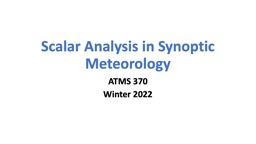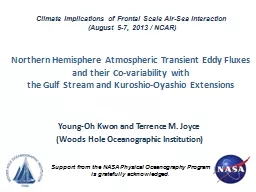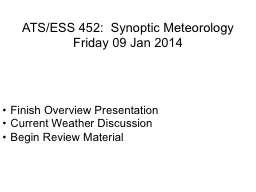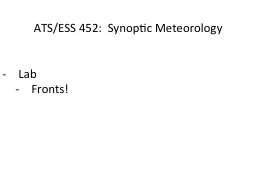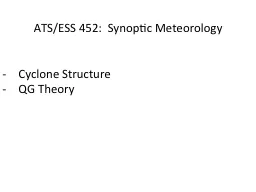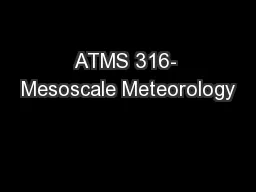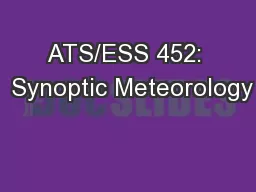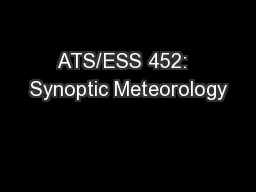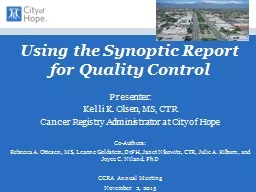PPT-Scalar Analysis in Synoptic Meteorology
Author : thomas | Published Date : 2023-10-04
ATMS 370 Winter 2022 Definition Scalar Analysis is the analysis of a quantity that has magnitude only Examples temperature and pressure Consists of drawing isopleths
Presentation Embed Code
Download Presentation
Download Presentation The PPT/PDF document "Scalar Analysis in Synoptic Meteorology" is the property of its rightful owner. Permission is granted to download and print the materials on this website for personal, non-commercial use only, and to display it on your personal computer provided you do not modify the materials and that you retain all copyright notices contained in the materials. By downloading content from our website, you accept the terms of this agreement.
Scalar Analysis in Synoptic Meteorology: Transcript
ATMS 370 Winter 2022 Definition Scalar Analysis is the analysis of a quantity that has magnitude only Examples temperature and pressure Consists of drawing isopleths line of constant values Topographic maps are good examples. MET 3502 Synoptic Meteorology Lecture 1: Introduction on Synoptic Meteorology Instructor: Dr. Haiyan Jiang Lecture Location: PC 442 Time: T & Th 11:00 am - 12:15 pm Introduction Introduction &#x and their Co-variability with . the Gulf Stream and Kuroshio-Oyashio Extensions. Young-Oh Kwon and Terrence M. Joyce. (Woods Hole Oceanographic Institution). Climate Implications of Frontal Scale Air-Sea Interaction. Friday 09 Jan 2014. Finish Overview Presentation. Current Weather Discussion. Begin Review Material. GOES-12 IR satellite image, 0615 UTC 19 August 2009. GOES-12 IR satellite image of Hurricane Bill at 0615 UTC 19 August 2009. By Kathy Lovett and Leah Smeltzer. Authors: Patrick S. Market, Rebecca L. Ebert-Cripe. Michael Bodner. March 23, 1966. 7" of snow fell in Eau Claire, Wisconsin. North of the city received as much as 18". Lab. Fronts!. Fronts!. What are fronts?. A narrow transition zone, or boundary, between differing synoptic scale air masses whose primary discontinuity is density. Fronts highlight . baroclinic. zones, where temperature advection and atmospheric energy is at work. Cyclone . Structure. QG Theory. NAM Forecast Sounding for this Saturday at 03 UTC (i.e., tonight near 9pm). In the . sfc. to ~700-mb layer, how are the winds turning with height?. Counter-clockwise. http://www.ucar.edu/communications/factsheets/Tornadoes.html. Packet#1. What is meant by “Mesoscale Meteorology”?. ATMS 316- Mesoscale Meteorology. http://www.ucar.edu/communications/factsheets/Tornadoes.html. Friday . 09. /. 26. /2014. Continue . Review Material. Geopotential. Thickness. Thermal Wind. Geopotential. , Thickness, and the Thermal Wind. What is . geopotential. ?. . Work. needed to lift a unit of mass from sea level to a given altitude…. A Consequence of the Quantum Trace Anomaly in Low Energy Gravity. . . E. . Mottola. . Los Alamos National Laboratory . . pre-print to appear April (2016) . Lecture . 1. AL-MUSTANSIRIYAH . UNIVERSITY . COLLEGE OF SCIENCES. ATMOSPHERIC SCIENCES DEPARTMENT . . Dr. . Sama. Khalid Mohammed. SECOND . CLASS . 1. 2. Weather Maps. Surface maps, upper air maps, Observation times and collection, codes, surface . Mesoscale. Processes Associated with a Lake-Effect . Snowband. Over Buffalo, NY During 18-19 November 2014.. Department of Atmospheric and Environmental Sciences. University at Albany-SUNY. ATM 509: Atmospheric Precipitation Processes. Course Overview & Logistics. Wed – 20 Aug 2014. Introductions…. Office: NSSTC 3088. Email: . ryan.wade@uah.edu. Phone: 961-7847 (office phone). Office Hours. :. MWF: 8:00am – 9:00am, 10:15am – 11:00am. 1. Sandia . National Laboratories is a multi-mission laboratory managed and operated by National Technology and Engineering Solutions of Sandia, LLC, a wholly owned subsidiary of Honeywell International, Inc., for the U.S. Department of Energy's National Nuclear Security Administration under contract DE-NA0003525. SAND2017-6417C. Presenter:. Kelli K. Olsen, MS, CTR. Cancer Registry Administrator at City of Hope. Co-Authors: . Rebecca A. Ottesen, MS, Leanne Goldstein, . DrPH. , Janet Nikowitz, CTR, Julie A. Kilburn, and Joyce .
Download Document
Here is the link to download the presentation.
"Scalar Analysis in Synoptic Meteorology"The content belongs to its owner. You may download and print it for personal use, without modification, and keep all copyright notices. By downloading, you agree to these terms.
Related Documents

